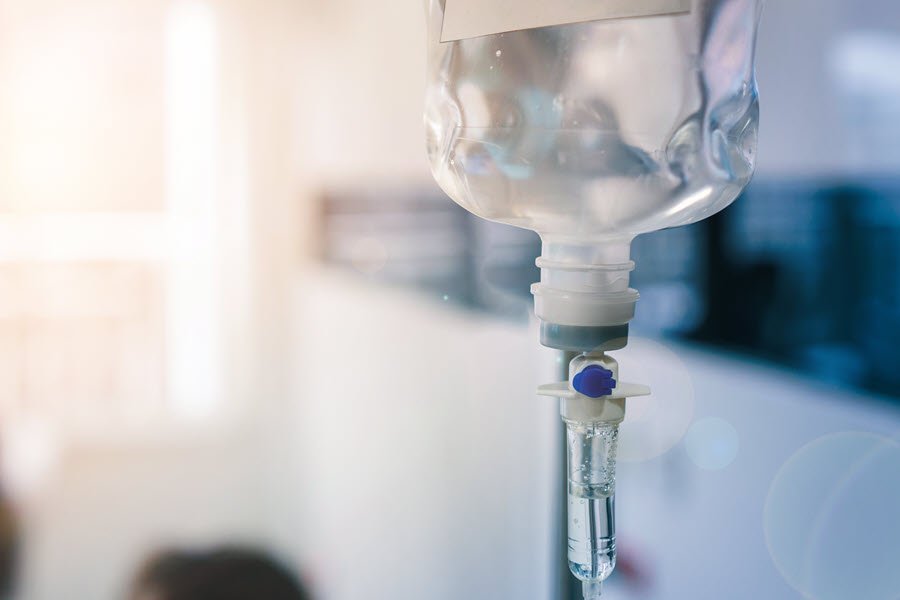99.9% of the time we see saline solution (aka: NSS, 0.9%NS) infused into a patient it is for hydration, and the correct code for the infusion is 96360 (+96361). But occasionally this ubiquitous IV solution is used for a therapeutic or diagnostic purpose. Being vigilant of the intention of the infusion helps us to select the correct infusion code.
Pay close attention to the descriptor for 96365: “Intravenous infusion, for therapy, prophylaxis, or diagnosis.” A provocative test is one in which the patient is subjected to a substance, stimulus, or maneuver which then elicits a measurable response, which can take the form of a positive lab test, a positive physiological measurement, or occurrence of a symptom. Let’s look at some examples we might encounter while coding where a diagnostic or therapeutic saline infusion would be correctly assigned 96365 instead of the hydration code 96360.

1. Hyperaldosteronism
In the saline suppression test for hyperaldosteronism, the patient is loaded up with salt via normal saline infusion, and then see if the level of aldosterone lowers as a response. Aldosterone basically keeps sodium in the body, so when the sodium load goes up (through NS infusion or otherwise), normally the aldosterone level would back off in response. In primary hyperaldosteronism, the level of aldosterone just stays high anyway.
2. Heart failure
Saline infusion is occasionally used to assess diastolic (aka: HFpEF, heart failure with preserved ejection fraction). This is the type of heart failure where the pumping action is good, but the filling action is faulty. The pulmonary wedge pressure (PWP, PAWP, or PCWP) is an indirect measurement of left atrial pressure. In diastolic heart failure, the blood flow through the left ventricle “backs up” due to the inability of the ventricle to relax and fill with the full volume of blood. This is manifested as increased pressure in the left atrium. In the test, the patient is infused with 0.5 – 1 liter of NS, and the PWP is measured. If it is increased, diastolic heart failure may be diagnosed.
3. Non-Epileptic Attack or Seizure (NEA, NES)
This is actually a placebo test wherein the provider attempts to provoke seizure-like activity from a patient by infusing normal saline. There is no physiological activity from the NS, but the patient may believe it is causing them to have a seizure. Nonetheless, this infusion is being done to establish a diagnosis, therefore 96365 is correct.
4. Hyponatremia and traumatic brain injury
In these cases, saline may be infused therapeutically to restore sodium to the body or increase the osmolarity of the blood to decrease cerebral edema (brain swelling). However the substance infused will by hypertonic saline, which is 3% or 5% sodium chloride compared to 0.9% for normal saline solution. This “hypertonic” part is more obvious, but it’s still worth looking out for while coding. Hypertonic saline infusion is definitely therapeutic, so 96565 is the right choice.
**The coding information and guidance in these posts are valid at the time of publishing. Learners are encouraged to research subsequent official guidance in the areas associated with the topic as they can change rapidly.

Ed O'Beirne, CCS, CHDA, CHPS, CDIP, PA, MHS
Ed has been in healthcare his entire career with 15 years as a clinician and 11 years in a variety of HIM coding related roles. After 4 years as a respiratory therapist and 11 years as an emergency medicine Physician Assistant, the fascination with reading, analyzing, and translating medical documentation overcame his desire to perform patient care. For a guy who with a habit for reading the Encyclopedia Brittanica, the Merck Manual, and medical records just for fun, HIM became a natural fit.
Documentation and coding audits are firmly in Ed’s skillset but educating coders is what really makes him tick. He is known for effectively integrating anatomy, physiology, pathophysiology, medicine, and detailed procedural descriptions into his coding education in all forms.
He is a BS graduate in Biology from Virginia Commonwealth University and Master of Health Sciences from Duke University. Obsessed with aviation, he has a pilot’s license, 1000 skydives, owned an ultralight for several years, and currently designs, builds, and flies radio controlled airplanes and drones. Ed lives in Virginia with his wife and two kids, and plays outside with them as much as possible.

CPT codes are assigned based on the amount of work done, not why it was done. Whether you’re giving Saline for dehydration or heart failure is irrelevant, since the amount work is the same. 96365 should never be assigned for Saline infusions, since there is a separate code for infusing a hydration solution.
Hi Sylvia,
Per CPT Assistant, December 2011, page 3, the assignment of codes for hydration (96360/96361) vs. hydration (96365-96368) depends on the primary reason for the encounter and whether any other I&I services are provided on the same day. This article goes on to say, “The therapeutic, prophylactic, and diagnostic injections and infusions codes 96365-96376 are specifically indicated to be used for rapid or bolus infusions other than hydration.” This advice is buried in this lengthy CPT Assistant article titled “Coding Clarification: Facility Reporting—Multiple Infusions (Codes 96360, 96361, 96365-96367)” and is consistent with the information published in the blog.
Hello Mr. O’Beirne,
I have a 42 years old female patient with short gut syndrome , who need IV fluid to maintain her hydration, so she does not go into re-renal azotemia. failure. ( admitted in past with dehydration and ARF due to high output ilestomy, she has no colon)
We monitor her electrolytes every week ( K, Mg, Phos) , and adjust IV fluid and saline accordingly.
What code should be used to cover _monitoring electrolyte and writing orders for IV fluid to maintain hydration?
This is done on weekly basis by reviewing the labs.
Patient cannot come to office due to transport issue.
Thank you in anticipation of your reply.
Hi Tusharsindhu,
Assign code K91.2, Postsurgical malabsorption, not elsewhere classified for short gut syndrome. Short bowel syndrome is a condition in which the body cannot absorb enough fluids and nutrients following removal of a portion of the small intestine. This code is supported by documentation that the reason for receiving IVF is short gut syndrome. If, for some reason, the payer does not cover this diagnosis for IVF, the claim should be appealed with clinical justification for the services.
Great blog post, Ed! I will encourage Stanford’s Outpatient Team to read through this to help them distinguish when to use 96365 for a saline infusion when it’s used for a therapeutic or diagnostic purpose.
What about a case where a liter of saline is given as a rapid infusion to create pressure to create a back pressure to “force” a calculus through a ureter.
This is a clever but effective way to briefly overhydrate patients to induce diuresis and accelerate passage of a stone. In relatively healthy patients with strong kidneys and circulatory function, the increased urine output can dilate the ureter and promote peristalsis so the stone is passed into the bladder. Though this is an indirect mechanism on the part of the saline infusion, it is definitely a therapeutic intervention with a very clear goal. Therefore it is recommended that it be coded as a therapeutic infusion if it is adequately documented as being for this purpose.